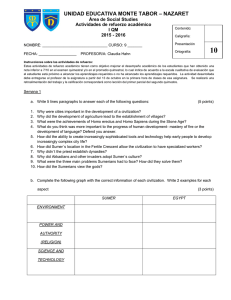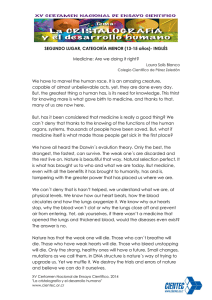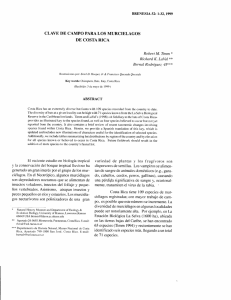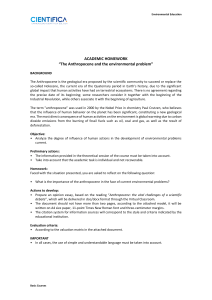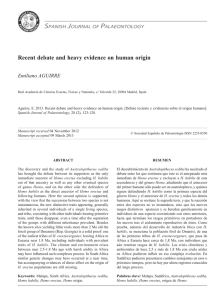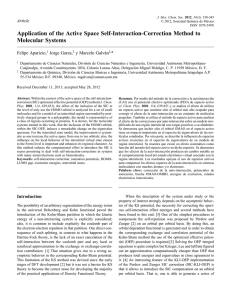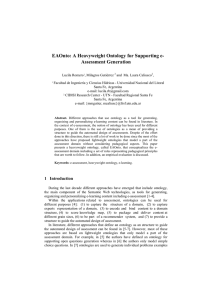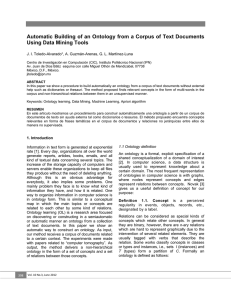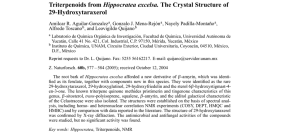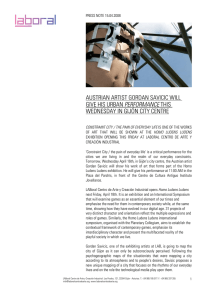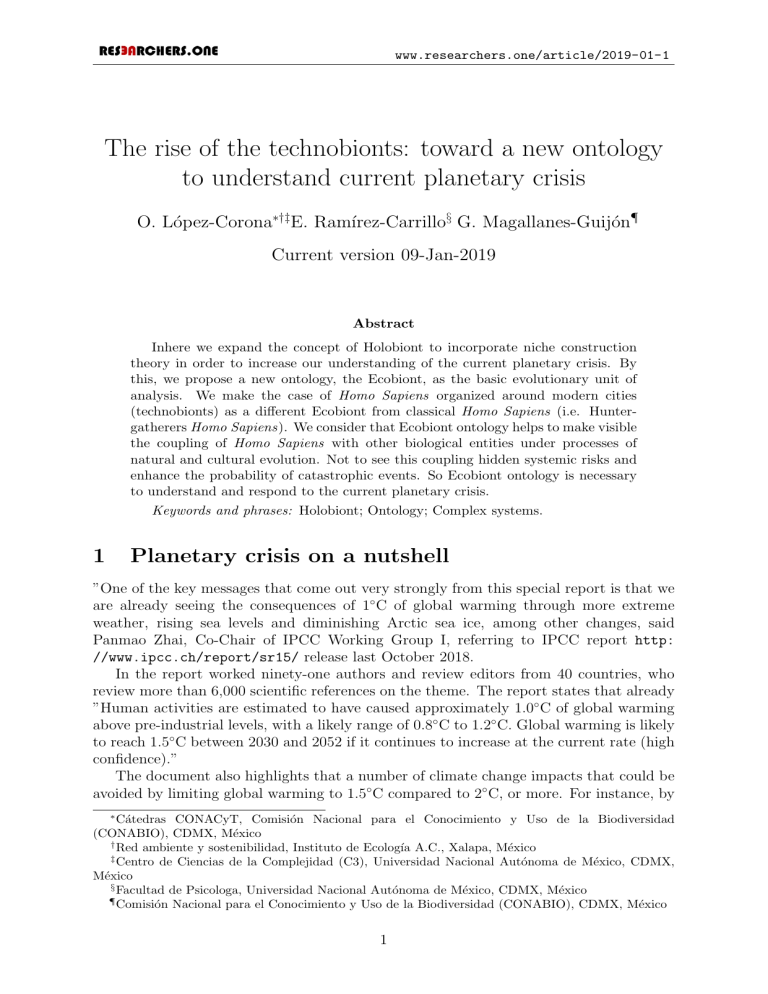
www.researchers.one/article/2019-01-1
The rise of the technobionts: toward a new ontology
to understand current planetary crisis
O. López-Corona∗†‡E. Ramı́rez-Carrillo§ G. Magallanes-Guijón¶
Current version 09-Jan-2019
Abstract
Inhere we expand the concept of Holobiont to incorporate niche construction
theory in order to increase our understanding of the current planetary crisis. By
this, we propose a new ontology, the Ecobiont, as the basic evolutionary unit of
analysis. We make the case of Homo Sapiens organized around modern cities
(technobionts) as a different Ecobiont from classical Homo Sapiens (i.e. Huntergatherers Homo Sapiens). We consider that Ecobiont ontology helps to make visible
the coupling of Homo Sapiens with other biological entities under processes of
natural and cultural evolution. Not to see this coupling hidden systemic risks and
enhance the probability of catastrophic events. So Ecobiont ontology is necessary
to understand and respond to the current planetary crisis.
Keywords and phrases: Holobiont; Ontology; Complex systems.
1
Planetary crisis on a nutshell
”One of the key messages that come out very strongly from this special report is that we
are already seeing the consequences of 1◦ C of global warming through more extreme
weather, rising sea levels and diminishing Arctic sea ice, among other changes, said
Panmao Zhai, Co-Chair of IPCC Working Group I, referring to IPCC report http:
//www.ipcc.ch/report/sr15/ release last October 2018.
In the report worked ninety-one authors and review editors from 40 countries, who
review more than 6,000 scientific references on the theme. The report states that already
”Human activities are estimated to have caused approximately 1.0◦ C of global warming
above pre-industrial levels, with a likely range of 0.8◦ C to 1.2◦ C. Global warming is likely
to reach 1.5◦ C between 2030 and 2052 if it continues to increase at the current rate (high
confidence).”
The document also highlights that a number of climate change impacts that could be
avoided by limiting global warming to 1.5◦ C compared to 2◦ C, or more. For instance, by
∗
Cátedras CONACyT, Comisión Nacional para el Conocimiento y Uso de la Biodiversidad
(CONABIO), CDMX, México
†
Red ambiente y sostenibilidad, Instituto de Ecologı́a A.C., Xalapa, México
‡
Centro de Ciencias de la Complejidad (C3), Universidad Nacional Autónoma de México, CDMX,
México
§
Facultad de Psicologa, Universidad Nacional Autónoma de México, CDMX, México
¶
Comisión Nacional para el Conocimiento y Uso de la Biodiversidad (CONABIO), CDMX, México
1
www.researchers.one/article/2019-01-1
2100, global sea level rise would be 10 cm lower with global warming of 1.5C compared
with 2◦ C. Hans-Otto Prtner, Co-Chair of IPCC Working Group II claim that: Every extra
bit of warming matters, especially since warming of 1.5◦ C or higher increases the risk
associated with long-lasting or irreversible changes, such as the loss of some ecosystems,
meaning we have a reinforce of negative global change processes.
And so, although Climate Change is an urgent issue that must be addressed immediately with clear and massive actions, it is far from being the only source of the current
Planetary Crisis. In a 2014 paper on Science, Dirzo and co-workers (11) said that ”We
live amid a global wave of anthropogenically driven biodiversity loss: species and population extirpations and, critically, declines in local species abundance.” According to their
study; among terrestrial vertebrates, 322 species have become extinct since 1500, and
populations of the remaining species show 25% average decline in abundance. Invertebrate patterns are equally dire: 67% of monitored populations show 45% mean abundance
decline.
In-face of this global pattern of defaunation, the authors warn that such animal declines will cascade onto ecosystem functioning and human well-being. They conclude that
”...defaunation is both a pervasive component of the planets sixth mass extinction and
also a major driver of global ecological change.”
In fact, besides Climate Change and Loss of Biodiversity, there are other seven biogeochemical processes recognized as the core of the current Planetary Crisis (see Fig.1),
that exhibits clear thresholds that if exceeded will lead to tipping points in the Earth
System (31).
To understand this, Kleidon suggests in (18) that we have to rethink Earth as a
complex thermodynamic system, that is maintained in a unique state far from thermodynamic equilibrium by maximizing the entropy production. To achieve this Maximum
Entropy Production (MEP) dynamics, Earth Systems carry out myriads of processes that
transform energy, that results in the mass movement in the atmosphere, in oceans, and
on land. But that ultimately all these local processes may cluster under some of the
global biogeochemical processes porpoised in (31).
Under steady-state conditions, when a maximum in entropy production is reached,
MEP implies that the Earth system reacts to perturbations primarily with negative feedbacks, reinforcing stability. But when external conditions change in such a way that the
trade-off between flux and force shifts a perturbation of the flux would be enhanced until
the flux reaches the new optimum value at which entropy production is at a maximum
(18).
In Prigogine’s out of equilibrium Thermodynamic Theory (29), Entropy Production
(σ) is given by the product of generalized forces (X) times their conjugates fluxes (J)
Z X
dS
=σ=
Xi J i
(1)
dt
i
where it is supposed that forces and fluxes have a linear relation given by
X
Xi =
Lij Jj
(2)
j
in which Lij are the Onsager coefficients.
Now let us consider that before the industrial revolution the Earth System had an
entropy profile (EP) as the solid black curve in figure . In that case under some perturbation (black arrow), the system would react with negative feedback (solid blue line)
2
www.researchers.one/article/2019-01-1
Figure 1: Planetary boundaries. The green areas represent human activities that are
within safe margins, the yellow areas represent human activities that may or may not
have exceeded safe margins, the red areas represent human activities that have exceeded
safe margins, and the gray areas with red question marks represent human activities
for which safe margins have not yet been determined. Taken from: https://commons.
wikimedia.org/wiki/File:Planetary_Boundaries_2015.svg
as porpoised in (25). But as anthropic activities force more and more Earth System, it
could be possible to achieve another maximum entropy profile as the case of the gray
dotted line for which the response of the system to perturbations would lead to positive
feedback (red solid line).
This kind of tipping point behavior related to Limit Cycles and Planetary Thresholds
has been studied recently in (39). In there, the authors explored the risk that selfreinforcing feedbacks could push the Earth System toward a planetary threshold that, if
crossed, could prevent stabilization of the climate at intermediate temperature rises and
cause continued warming on a Hothouse Earth pathway even as human emissions are
reduced.
2
From the Holocene to the Anthropocene
Key state variables of the Earth System (i.e. rain pattern, N2 cycling or ocean’s temperature among others) exhibits natural fluctuations as registered for example in the
420,000-year Vostok (Antarctica) ice core record (27). Interestingly enough, as pointed
out in Fig. 3, for most of the last 10,000 years Earth has remained within what is
3
www.researchers.one/article/2019-01-1
Figure 2: Under some set of perturbation (black arrow) and Entropy Profile (EP) represented by black line-arc the system would react with a negative feedback (solid blue line)
as porpoised in (25). But as anthropic activities force more and more Earth System, it
could be possible to achieve another New Entropy Profile (NEP) as the case of the gray
dotted line, the response of the system to perturbations would lead to positive feedback
(red solid line).
called the Holocene Stability Domain (HSD). The MEP mechanism of the planet has
kept these key biochemical and atmospheric parameters fluctuating within a relatively
narrow range (31). This increase of stability coincides with the emergence of Agriculture
and subsequent civilization development.
The current dominant theory about speciation of Homo Sapiens out of archaic human
varieties derived from Homo Erectus is estimated as having taken place over 350,000 years
ago (light green area in Fig.3) (36). Since then and for must of our existence as Homo
Sapiens, we have been organized in small nomadic groups of hunter-gatherers.
All animal populations, including Homo Sapiens, are sustained by fluxes of matter,
energy and information from a finite environment within Physical constraints under evolutionary process. As a result, it is well known the existence of several scaling relations,
such as the metabolic rate scaling as the 3/4-power of mass over 27 orders of magnitude,
from molecular and intracellular levels up to the largest organisms (see Fig.4) (46; 47).
Contrary to noble savage myths, early humans started to become a source of environmental impact pretty soon as evidence by late Pleistocene extinctions of megafauna,
due at least in part to human hunting pressures (16); or by the domestication of several
animals converting for example Canis Lupus to Canis Lupus Familiaris about 100,000
years ago; and in general predating and modification of landscapes, often through the
use of fire (30).
4
www.researchers.one/article/2019-01-1
Figure 3: Data of Temperature anomaly (Celcius) from 420,000-year Vostok (Antarctica)
ice core record (https://gcmd.gsfc.nasa.gov). The reference zero is present year and
to the right we have the past in a scale of 103 years. Some important events for Homo
Sapiens are marked in the figure. The appearance of Homo Sapiens is in light-green
area, whereas Holocene Stability Domain (HSD) correspond to rectangle and inside it in
dark-green is the Antropocene or porpoised Technocene
Figure 4: Taken from (47) under CC terms. Basal metabolic rate for mammals as a
function of body mass on a logarithmic scale (blue circles). The solid blue line represents
the predicted three-quarter power scaling law, covering over six orders of magnitude in
mass from a shrew to an elephant. Values for cells in vivo for these same mammals are
shown as a vertical blue band at a cellular mass of 3 109 g. These are related to the
corresponding whole mammal values by a linear relationship, Eq. 2, as shown by the
dashed blue lines. The upper dashed blue line is predicted to intercept the solid blue line
at M = , close to the mass of a shrew, and to extrapolate to the value for an isolated
cell in vitro (red data point; see Fig. 2). Also shown (red dots) are in vivo values for a
mitochondrion, the respiratory complex, and a cytochrome oxidase molecule
5
www.researchers.one/article/2019-01-1
Early humans used the considerable power of fire to their advantage, for example
keeping dangerous animals at a respectful distance, especially during the night, and
helped in hunting protein-rich, more easily digestible food. But as important as it was
the real historical shift started with the emergence of agriculture (38).
At the beginning of the century, Paul Crutzen and Eugene Stoermer proposed that
human modification of the global environment had become significant enough to warrant
termination of the current Holocene geological epoch and the formal recognition of a new
Anthropocene epoch (Crutzen and Stoermer, 2000; Crutzen, 2002).
This proposal of Anthropocene as a new geological epoch is based on the accumulative evidence that human activities have made so profound perturbations on essential
planetary processes, that not only we are nearby a planetary tipping point as described
in the above section, but they have already driven the Earth out of the HSD in which
agriculture, sedentary communities, and eventually, socially and technologically complex
human societies flourish (39).
Most interestingly, Burger and co-workers (4) have shown (See Fig.5,6) that even
from pre-industrial but mostly modern Homo Sapiens living in cities are completely out
of energy consumption scaling relation valid for every other animal.
The main idea of the authors is that Homo Sapiens, as well as any other species,
are subject to fundamental biophysical laws. For example, it is expected that all species
in a given environment flux the same amount of energy on average, corresponding to a
zero-sum energy game (43; 44).
Figure 5: Red circles represent vegetarian hunter-gatherers (n=31), blue circles are preindustrial societies (n=4), purple circles are modern cities (n=163), and green triangles
are other herbivorous land mammal species (n=74). Note that the slope for cities is
shallower than herbivorous land mammals, which support theoretical predictions of 1.
See supplemental materials for additional details and data sources. Taken from (4) under
http://creativecommons.org/licenses/by/4.0/
This prediction has been shown (7; 8) using the energetic-equivalence rule (EER) that
links individual metabolic requirements to population energy use in space and time in
such a way that there should be a power law between Energy use (Ei ) and population
density (D) as the blue one in Fig.5 that applies well for land mammals including Homo
Sapiens organized as Hunter-gatherers.
Nevertheless, modern Homo Sapiens organized in pre-industrial societies are already
far of the above behavior mostly to his capacity to harness extra-metabolic energy in the
6
www.researchers.one/article/2019-01-1
Figure 6: Red circles represent vegetarian hunter-gatherers (n=31), blue circles are preindustrial societies (n=4), purple circles are modern cities (n=163), and green triangles
are other herbivorous land mammal species (n=74). Ep is estimated as the product of
density (individuals/km2) and Ei (watts). Note that population energy use for herbivorous land mammals does not vary with individual energy use supporting theoretical
expectations (slope=0), whereas urban cities increase (positive slope). The dashed line
represents the terrestrial average net primary productivity for the planet from (15). Taken
from (4) under http://creativecommons.org/licenses/by/4.0/
form of renewable and fossil fuels to power modern agricultural-technological-industrial
lifestyles. Even more, Homo Sapiens under modern cities organization are quite of chart
reaching values of 10,000 watts, compared to 120 watts of biological metabolism in
hunter-gatherers organization (two orders of magnitude more). So clearly, not only humans have deviated from other species in their energy use, there are two orders of difference between hunter-gatherers and urban Homo Sapiens.
In Fig.6 it is shown that unique to urban humans is the positive relationship between
population energy flux and per capita energy requirements whereas other land mammals
show a slope indistinguishable from 0 as the theory predicts. Interestingly to note that
no other land mammal on earth has ever organized itself in such a way that its energy
flux is higher than Global Average Net Primary Productivity.
These two results are so different for Homo Sapiens organized in modern cities that
leads to the question if those are the same kind of organism that Hunter-gatherers in
terms of Earth System functioning.
In this work, we porpoise that in order to understand and respond adequately to
current Planetary Crisis we need to introduce a new ontology that captures this clear
departure of modern urban Homo Sapiens from Hunter-gatherer Homo Sapiens. We call
this ontology the Ecobiont and the particular kind of Ecobiont corresponding to modern
urban Homo Sapiens the Technobiont.
7
www.researchers.one/article/2019-01-1
3
The new Ecobionts ontology
According to Bunges Dictionary, ontology is the branch of philosophy that studies the
most pervasive features of reality [...] Ontology does not study constructs, i.e. ideas in
themselves(3). This means that ontology is, in a broad aspect, the more general class of
theories about the world.
We are going to use the ontology concept from the point of view of the philosopher W.
V. O. Quine(49) who argue that the scientists are committed to accepting the existence
of those entities that are truth-makers of the theory.
The philosopher says in his text On what there is:
Our ontology is determined once we have fixed upon the over-all conceptual
scheme which is to accommodate science in the broadest sense; and the considerations which determine a reasonable construction of any part of that conceptual scheme, for example, the biological or the physical part is not different
in kind from the considerations which determine a reasonable construction of
the whole.1
With this, the notion of ontology is in the sense of a simplest conceptual scheme where
the pieces of the entities puzzle can be ordered in a reasonable theoretical construction.
And following the ideas on how to model ecological and evolutionary processes as in
(6; 22) let us consider a multidimensional Abstract Resources Space (ARS) in which a
resource could be biotic (bαi ), such as genome, microbiome and so on; abiotic (aαj ) such as
nutrients or solar energy for example; or social resources (sαk ) including culture, economy
and technology.
Then we define the Ecobiont (α) represented as the vector EB α in this ARS
EB α = (aα1 , . . . , aαn , . . . , bα1 , . . . , bαm , . . . , sα1 , . . . , sαl ).
(3)
We claim that this definition of Ecobiont takes the idea of the Tangled Nature
Model(6), which has been considered as a valid idealization of the quasi-species model in
a frequency-dependent fitness landscape(10), a two-step forward.
But also, the ontology of Ecobiont would be a physical object (21), meaning: that
the object should be subjective-invariant. (It means that the object should be invariant
on respect to any subject, where the subject may be a researcher or a scientific community with its instruments of measurement and observation. Besides, it should have its
theoretical framework.) And it should be be susceptible of contrast. (This means that
the object should be susceptible to be contrasted between theoretical predictions and its
experimental behavior).
The first step is based on the idea of Holobionts as units of selection and as a model
of their population dynamics and evolution as porpoised in (32). Where the authors define Holobionts as ”..., consisting of a host and diverse microbial symbionts, function as
distinct biological entities anatomically, metabolically, immunologically, and developmentally. Symbionts can be transmitted from parent to offspring by a variety of vertical and
horizontal methods. Holobionts can be considered levels of selection in evolution because
they are well-defined interactors, replicators/reproducers, and manifestors of adaptation”
The importance of microbiome in evolutionary process has attracted a lot of attention
recently. For example in (33) the authors say that evolutionary theories need to be
1
Quine, W.V. (1948). On what there is. Review of Metaphysics. P. 9.
8
www.researchers.one/article/2019-01-1
recast in the light of microbiome discoveries to fully understand and incorporate the
role of microbes in our evolution. Fundamental evolutionary concepts such as diversity,
heredity, selection, speciation, etc., which constitute the modern synthesis, are now being
challenged, or at least expanded, by the emerging notion of the holobiont. In a subsequent
paper, the authors claim that they have constructed the first model in which symbiotic
interactions, diversity, specialization and dysbiosis in an ecosystem emerge as a result of
coevolution (17) .
The second step is to incorporate the environment of the Holobiont as an integral
part of its evolutionary process. For example to define Puma concord in this Ecobiont
ontology it is not enough to think in Puma concord as in the Entangled Nature Model
because it does not evolve in an isolated manner, for the contrary, it is co-evolving, for
example with its biotic network of prays. Even more, all organism regularly modify local
resource distributions, influencing both their ecosystems and the evolution of traits whose
fitness depends on such alterable sources of natural selection in environments (19).
The clearest example of this is the co-evolution of life as a whole and the atmosphere
chemical constitution. The coupled evolution of land plants, CO2, and climate over the
last half billion years has maintained atmospheric CO2 concentrations within finite limits,
indicating the involvement of a complex network of geophysiological feedbacks (1). It has
been even suggested that from a thermodynamic perspective, life is a dynamic, out of
equilibrium process, stabilizing and coevolving in concert with its abiotic environment.
Then Life could be seen as a catalyst for entropy production through the water cycle, and
ocean and wind currents, linking biotic processes to abiotic processes with the universal
goal of increasing Earths global entropy production and thus provides a framework within
which coevolution of the biotic with the abiotic can be studied (23). Other authors
consider that from a geological point of view, life is an integrated part of the exogenic
cycle, and one may regard the biosphere as a laminar, highly activated global envelope,
energized by solar radiation, modeling the terrestrial physiognomy, and catalyzing major
geochemical reactions. In other words, Life is a Geological force (48).
Finally when we think in the environment we are not only considering the physical
one but also the social environment as well. Lalland and co-workers in (20) propose a
conceptual model that maps the causal pathways relating biological evolution to cultural
change. A process usually integrated with the concept of Niche Construction and which
refers to the activities, choices, and metabolic processes of organisms, through which they
define, choose, modify, and partly create their own niches. Niche-constructing organisms
may also substantially modify the environment of their offspring, and even more distant
descendants. Thus, generations of organisms inherit not only genes from their ancestors
but also a legacy of natural selection pressures that have been modified by ancestral niche
construction. This legacy of modified selection pressures has previously been labeled an
ecological inheritance but the authors expand the concept of cultural inheritance. But
in addition to being the Ecobiont a physical object, it can be examined by the scientific
community to corroborate the theoretical scope proposed here and take it in contrast
with the evidence.
In this theoretical model, we consider that although the hologenome already provides
an evolutionary functional unit, the social context modulates these processes generating
a kind of effective evolution. In this way we should recognize effects of modulation in the
anatomy of the holobionts, in their metabolism, immune system, or in their development,
all of them modifying their fitness or their niche and therefore intervening in the selection
processes.
9
www.researchers.one/article/2019-01-1
Figure 7: Theoretical model for the Ecobiont Ontology. We consider a set of interacting
pools (genes, microbiome and social) that co-evolve from some arbitrary time t to t’, by
means of natural selection and niche construction. In the co-evolutionary multidimensional process Gi is the genotype of the population i that is coupled with its symbionts
(gi ) and together as an holobiont co-evolve with local environment Ei forming one coherent evolutionary unit; which in turn co-evolve in parallel with many other of this units
or Ecobionts.
As an example, there is a current trend of wearable robotics which is a promising
way of integration between humans and robots. Typically wearable robot is intended
to be a way to substitute missing parts of the human body, by means of a prosthesis
or to enhance human body force and precision capabilities, by means, for example, of
exoskeletons (2; 5; 51; 52). Recent developments (28) go beyond this in what may be
call Enhance Human Technology (EHT), building prosthesis not to replace but to add
functionality to the human body, in the form for example of a second thumb.
Even more, a recent in-depth article in Science (37) the authors discuss how we
are entering into a new era in bioelectronics, developing devices that can be integrated
seamlessly into nervous tissue. As good as it sounds in terms of innovative treatments in
humans for everything from blindness and paralysis to brain diseases such as Parkinson’s
and Alzheimer’s, this new technology can carry inputs as well as outputs, the day when
bioelectronics will not just monitor animal behavior, but also control it, is then not far
off. So the authors claim that these advances are beginning to dissolve the boundary
between living organisms and the outside world.
If this anatomical modulation through a socio-cultural process (technology only one
of many possible) carry with them fitness modulation in terms for example of sexual
selection (as with Padaung woman in Thailand) or economic benefits that if maintained
could have evolutionary effects. On this issue, Laland and co-workers have porpoise that if
the cultural inheritance of an environment-modifying human activity persists for enough
10
www.researchers.one/article/2019-01-1
generations to achieve a stable selection pressure, it will be able to codirect human genetic
evolution (20).
Take the classic example of Kwa-speaking yam cultivators in West Africa. These
people increased the frequency of a gene for sickle-cell anemia in their own population as
a result of the indirect effects of a socio-cultural process: the yam cultivation. By making
clearings in the rainforest for the yam cultivation, they created more standing water and
increasing the breeding grounds for malaria-carrying mosquitoes. This, in turn, intensifies
selection for the sickle-cell allele because of the protection offered by this allele against
malaria in the heterozygotic condition (12).
In another type of examples, recently the significance of the relationship between gut
microbiota and its mammalian host in the pathogenesis of obesity and the metabolic
syndrome has been demonstrated and emerging data has linked intestinal dysbiosis to
several gastrointestinal diseases (including inflammatory bowel disease, irritable bowel
syndrome, nonalcoholic fatty liver disease, and gastrointestinal malignancy) (26). There
are clear socio-cultural processes that affect microbiome. Ingestion of a Western Diet
(WD) that is high in saturated fat and added sugars negatively impacts microbiome and
cognitive functions (24); extensive and even excessive antibiotic use (or overuse) has severe
consequences linked to obesity, allergies and microbiome dysbiosis (9). Most interesting,
a recent work (34) has shown that maternal high-fat diet (HFD) affects third-generation
female body mass via the paternal lineage. We showed here that the offspring born to
HFD ancestors displayed addictive-like behaviors as well as obesity and insulin resistance
up to the third generation in the absence of any further exposure to HFD. In this way,
not only this microbiome adverse socio-cultural processes are inherited (20), but their
effect is also past to following generations.
Most interesting is that under this ontology we may be in place to start to formalize
it under the scope of out of equilibrium thermodynamics. Following (22) we may understand Ecobionts co-evolutionary process in the multidimensional ARS as an atomic
cluster in which for example temperature, kinetic energy in atomic clusters, corresponds
to mutations, abiotic resource or socio-cultural fluctuations. In the same way collective
movement that in the atomic cluster give place to isomerization, in the Ecobiont model
results in an evolutionary episode.
Under this theoretical framework one may define the different types of interactions,
the ones between Ecobionts and environment (E1 ), interEcobiontical (E2 ) such as competition, parasitism, or symbiosis; and the intraEcobiontical (E3 ) between members of
the same type of Ecobiont due to competition arising from the limited carrying capacity
of the local environment.
Let pα be the population of EB α Ecobiont, k α a constant and rα the root mean square
value of ARS gradient. Then the interaction of Ecobionts and the ARS is proportional
to resource gradient.
E1 = k α rα
(4)
Taking the typical functional forms types for interactions in physics, the E2 component of the interactions should be a function of the distance between them in resource
space. Because of competition for resources between Ecobionts located close together in
resource space, the interaction should be repulsive (increasing the free energy) at short
distance and banish when distance tends to infinity. For intermediate distance Ecobionts
interaction could be attractive when physical association exists in form of symbiotic or
parasitic interdependence; repulsive when resource competition dominate. In this way
11
www.researchers.one/article/2019-01-1
E2 = rα rβ {Lαβ exp [−u (rαβ − 1)]} − Mαβ exp [−v (rαβ − 1)] ,
(5)
where the Lαβ coefficient is positive defined representing repulsion due to competition
for resources in the ARS. The constants u, v most by such that u >> v in order to
capture only two Ecobionts interaction in a specific hypervolume of the ARS. The sign
of the coeffcient Cαβ is defined as
Cαβ , Cβα < 0 for competition interaction
Cαβ Cβα < 0 for parasitism interaction
(6)
Cαβ Cβα > 0 for symbiotic interaction
Cαβ , Cβα = 0
for null interaction
The product rα rβ represents the increasing interaction strength between Ecobionts α
and β as either any of them increases its resource gradient requirement. And rαβ the
distance rαβ = krα − rβ k between Ecobionts α and β.
Finally the E3 component is defined by
Bαα rα2 ;
0 < rα < k
E3 =
(7)
→ ∞; rα ≤ 0, rα ≥ k
with Bαα a positive defined intersction coefficient, and k a resource boundary related
with carrying capacity of the ARS.
In this way we can define the internal energy of the system as
#
"
X
X
p2α
(8)
pα pβ E2 (rα rβ ) + E3 (rα )
pα E1 (rα ) +
U=
2
α
α6=β
If appropriate vibrational and translational entropies are calculated then as shown
by Michaelian in (22) one may write the entire Helmholtz energy F = U − T S, with U
as define above and T being the temperature as discuss early. Then the destiny of the
Ecobionts cluster will be defined by minimizing F that may be accomplished by means
of a genetic algorithm as occur in nature.
4
The rise of the Technobionts
Modern urban Homo Sapiens has become a Planetary force with mostly negative impact
among others Climate Change and loss of Biodiversity which seems to be accelerated or
magnified by socio-cultural process especially technology and economy.
According to Young and co-workers in (50), mayor environmental impacts may be
started as early as 10,000 years ago with the emergence of the agriculture which was a
major turning point in the development of the human enterprise, with significantly more
extensive modifications of the environment at larger scales. The two most important in
terms of biophysical impacts were the clearing of forests and the tilling of grasslands for
agricultural crops and the irrigation of rice. In some cases, these practices dramatically
altered landscapes at a regional level. However, the rate and geographical scale of the
spread of agriculture were still modest enough to produce no significant impacts on the
dynamics of the Earth System. There is no strong evidence from global environmental
records of human impacts associated with early agriculture. Social-ecological systems
operated at the local and regional scales.
12
www.researchers.one/article/2019-01-1
In that sense, it has been suggested that meanwhile, the negative environmental
impacts remain local ecosystems tends to avoid catastrophic tipping points (35).
So for us, the point is not if Homo Sapiens generate negative impacts or not, but
when do this impacts propagates beyond the local scale. This is very interesting because
information propagation (impacts for example) propagating through multiple scales happens at high levels of complexity reaching the maximum percolation at criticality. We
have probed in a paper under review, that time series complexity of magnetization and
energy from 2D Ising model is reached a critical temperature.
As shown in Fig.6 Homo Sapiens has strongly departed from natural scaling relation at
least from pre-industrial time and clearly in the modern urban organization. Interestingly
enough this period from pre-industrialisation to modernity is also a major period of
complexation.
We coin the term Technobiont to refer to Homo Sapiens under modern urban organization far away from natural scaling. In this way, we consider that we are more than
in a Technocene instead of Anthropocene because for several tens of thousands of years,
Homo Sapiens remains under the natural restrictions in terms of scaling for example or
extension of its impacts.
Our current technology trends point to a more profound irruption in the dimensions
that define Ecobiont’s ontology. There could be two Homo Sapiens Ecobionts type living
together: Classical Homo Sapiens (CHS)considered as Homo Sapiens not living in modern urban organization with energy scaling between Homo Sapiens hunter-gatherer and
pre-industrial Homo Sapiens; and on the other hand we have Technobiont understood
as Homo Sapiens living under modern urban organization far away from CHS energy
scaling.
As resource gradient required by Technobionts is much higher that CHS, and most
likely to be a zero-sum interaction. Then by E2 a very intensive competitive interaction
is excepted and there for concerns about the possibility of co-existence arise not only
between Technobionts and CHS but with all the rest of Ecobionts as well.
Recently Elon Musk (Tesla’s CEO) said ”people must become cyborgs to stay relevant” and has raised at least $27 million for Neuralink Corp., a startup developing braincomputer interfaces (see https://www.youtube.com/watch?v=ycPr5-27vSI). Digiwell
a biohacking startup estimate there are about 100,000 cyborgs worldwide. Humanity cant
wait millions of years for evolution to improve their brains and bodies, Kramer (DigiWell
CEO) says. Thats why were doing it ourselves.
In spite of the well documented planetary crisis described in first section, as a result
of the rise of the Technobionts, West in (45) somehow suggest that Technobions (not in
that term, he refers to cities) are at the same time the source of the problem and the only
possible source for its solution. He points out that because creativity and innovation scale
super-linearly with population, then cities provided us with a unique demographic bonus.
From this, one narrative could go by telling that as we have perturbed earth system so
much (maybe beyond tipping point) the only way to avoid annihilation as species is
accelerating our technological coupling, just as one has to push the accelerator in order
to not crash on high-speed curve taking. In a first stage if we inject great quantities
of resources to Technobionts an increment in environmental impacts should be excepted
but then a Kuznets curve effect in function of technology coupling could be reached and
impacts could drastically be reduced.
Nevertheless, this argumentation is based on the ontology of individuals of biological
species. In that respect, we think it is undoubted that we are in a revolution of our un13
www.researchers.one/article/2019-01-1
derstanding of what basic biological study unit is. Animals can no longer be considered
individuals in any sense of classical biology: anatomical, developmental, physiological,
immunological, genetic, or evolutionary. Thus, the holobiont, with its integrated community of species, becomes a unit of natural selection whose evolutionary mechanisms
suggest complexity hitherto largely unexplored (13)
There is a clear need to unveil the links between the units, the systems and the
processes of cultural and biological evolution. Knowledge of them could provide us with
important not to say vital clues on how to change social institutions and technologies
in accordance with, not only more ecologically driven ethics but the long-term interest of
our Ecobiont. (14).
5
Conclusions
Under the Ecobiont ontology, we clearly see that accelerating the technological coupling
could very easily lead two the extinction of CHS. The first avenue of extinction is by means
of competitions and assimilation, meaning that technological shift became so ubiquitous
that CHS will disappear by cultural processes. The second venue is that environmental
impact related to the rise of the technobionts make earth system incompatible with CHS
way of living, of course, Technobionts can always move to Mars, for example, buy not
CHS. Bottom line we as society have to decide if we want to survive current planetary
crisis only as species or as Ecobiont, which implies co-maintain not only our classic
biological identity but also the other dimensions of what we may consider makes us
human.
Of course, it could be the case of win-win events in which Tecnobiont rise leads to West
kind of scenario in a way compatible with CHS. Nevertheless as there is a catastrophic
scenario at least for CHS (and no doubt for a lot of other Ecobionts, we are in a mass
extinction event already) we should include a Precautionary Principle analysis as used
in (42) from which most likely the technological coupling acceleration strategy should be
avoided or restricted by incorporating, for example, Taleb’s Skin in the Game principle
(41). Skin in the game is a ”global and morally mandatory heuristic that anyone involved
in an action which can possibly generate harm for others, even probabilistically, should
be required to be exposed to some damage, regardless of context. While perhaps not
sufficient, the heuristic is certainly necessary hence mandatory. It is supposed to counter
voluntary and involuntary risk hiding and risk transfer in the tails” (40).
We consider that Ecobiont ontology helps to make visible the coupling of Homo Sapiens with other biological entities under processes of natural and cultural evolution. Not
to see this coupling hidden systemic risks and enhance the probability of catastrophic
events. So Ecobiont ontology is necessary to understand and respond to the current
planetary crisis.
Acknowledgments
OLC thanks Cátedras CONACyT fellowship program (project number 30) and Sistema
Nacional de Investigadores (62929).
14
www.researchers.one/article/2019-01-1
References
[1] David J Beerling and Robert A Berner. Feedbacks and the coevolution of plants and
atmospheric co2. Proceedings of the National Academy of Sciences, 102(5):1302–
1305, 2005.
[2] Massimo Bergamasco, Benedetto Allotta, L Bosio, Luca Ferretti, G Parrini,
GM Prisco, Fabio Salsedo, and G Sartini. An arm exoskeleton system for teleoperation and virtual environments applications. In Robotics and Automation, 1994.
Proceedings., 1994 IEEE International Conference on, pages 1449–1454. IEEE, 1994.
[3] Mario Bunge. Phylosophical dictionary. Prometheus Books: Amherst, 2003.
[4] Joseph R Burger, Vanessa P Weinberger, and Pablo A Marquet. Extra-metabolic
energy use and the rise in human hyper-density. Scientific reports, 7:43869, 2017.
[5] Maria Chiara Carrozza, C Suppo, Fabrizio Sebastiani, Bruno Massa, Fabrizio Vecchi,
Roberto Lazzarini, Mark R Cutkosky, and Paolo Dario. The spring hand: development of a self-adaptive prosthesis for restoring natural grasping. Autonomous Robots,
16(2):125–141, 2004.
[6] Kim Christensen, Simone A Di Collobiano, Matt Hall, and Henrik J Jensen. Tangled
nature: a model of evolutionary ecology. Journal of theoretical Biology, 216(1):73–84,
2002.
[7] John Damuth. Population density and body size in mammals. Nature, 290(5808):699,
1981.
[8] John Damuth. Interspecific allometry of population density in mammals and other
animals: the independence of body mass and population energy-use. Biological
Journal of the Linnean Society, 31(3):193–246, 1987.
[9] Jean de Gunzburg, Amine Ghozlane, Annie Ducher, Emmanuelle Le Chatelier,
Xavier Duval, Etienne Ruppé, Laurence Armand-Lefevre, Frédérique Sablier-Gallis,
Charles Burdet, Loubna Alavoine, et al. Protection of the human gut microbiome
from antibiotics. The Journal of infectious diseases, 217(4):628–636, 2017.
[10] Simone Avogadro Di Collobiano, Kim Christensen, and Henrik Jeldtoft Jensen. The
tangled nature model as an evolving quasi-species model. Journal of Physics A:
Mathematical and General, 36(4):883, 2003.
[11] Rodolfo Dirzo, Hillary S Young, Mauro Galetti, Gerardo Ceballos, Nick JB Isaac,
and Ben Collen. Defaunation in the anthropocene. science, 345(6195):401–406, 2014.
[12] William H Durham. Coevolution: Genes, culture, and human diversity. Stanford
University Press, 1991.
[13] Scott F Gilbert, Jan Sapp, and Alfred I Tauber. A symbiotic view of life: we have
never been individuals. The Quarterly review of biology, 87(4):325–341, 2012.
[14] Miguel A Gual and Richard B Norgaard. Bridging ecological and social systems
coevolution: A review and proposal. Ecological economics, 69(4):707–717, 2010.
15
www.researchers.one/article/2019-01-1
[15] Helmut Haberl, K Heinz Erb, Fridolin Krausmann, Veronika Gaube, Alberte Bondeau, Christoph Plutzar, Simone Gingrich, Wolfgang Lucht, and Marina FischerKowalski. Quantifying and mapping the human appropriation of net primary production in earth’s terrestrial ecosystems. Proceedings of the National Academy of
Sciences, 104(31):12942–12947, 2007.
[16] C Vance Haynes, PS Martin, and RG Klein. Stratigraphy and late pleistocene
extinction in the united states. Quaternary Extinctions: a prehistoric revolution,
pages 345–353, 1984.
[17] Saúl Hutzil, Santiago Sandoval-Motta, Alejandro Frank, and Maximino Aldana.
Modeling the role of the microbiome in evolution. Frontiers in Physiology, 9:1836,
2018.
[18] Axel Kleidon. Nonequilibrium thermodynamics and maximum entropy production
in the earth system. Naturwissenschaften, 96(6):1–25, 2009.
[19] Kevin N Laland, F John Odling-Smee, and Marcus W Feldman. Evolutionary consequences of niche construction and their implications for ecology. Proceedings of the
National Academy of Sciences, 96(18):10242–10247, 1999.
[20] Kevin N Laland, John Odling-Smee, and Marcus W Feldman. Niche construction,
biological evolution, and cultural change. Behavioral and brain sciences, 23(1):131–
146, 2000.
[21] Marco Antonio Martı́nez Negrete. La construcción del objeto fı́sico en la enseñanza
de la termodinámica y la mecánica. Revista Mexicana de Fı́sica, 45(4):405–413, 1999.
[22] Karo Michaelian. A physical basis of evolution and speculation on an evolutionary
basis of physics. Topics in Contemporany Physics, pages 195–210, 2000.
[23] Karo Michaelian. Thermodynamic function of life. arXiv preprint arXiv:0907.0040,
2009.
[24] Emily E Noble, Ted M Hsu, and Scott E Kanoski. Gut to brain dysbiosis: mechanisms linking western diet consumption, the microbiome, and cognitive impairment.
Frontiers in behavioral neuroscience, 11:9, 2017.
[25] Hisashi Ozawa, Atsumu Ohmura, Ralph D Lorenz, and Toni Pujol. The second
law of thermodynamics and the global climate system: A review of the maximum
entropy production principle. Reviews of Geophysics, 41(4), 2003.
[26] Parth J Parekh, Luis A Balart, and David A Johnson. The influence of the gut
microbiome on obesity, metabolic syndrome and gastrointestinal disease. Clinical
and translational gastroenterology, 6(6):e91, 2015.
[27] JR Petit, J Jouzel, D Raynaud, NI Barkov, JM Barnola, I Basile, M Bender, J Chappellaz, J Davis, G Delaygue, et al. Vostok ice core data for 420,000 years. IGBP
PAGES/World Data Center for Paleoclimatology Data Contribution Series, 76:2001,
2001.
16
www.researchers.one/article/2019-01-1
[28] Domenico Prattichizzo, Monica Malvezzi, Irfan Hussain, and Gionata Salvietti. The
sixth-finger: a modular extra-finger to enhance human hand capabilities. In Robot
and Human Interactive Communication, 2014 RO-MAN: The 23rd IEEE International Symposium on, pages 993–998. IEEE, 2014.
[29] Ilya Prigogine. Introduction to thermodynamics of irreversible processes. New York:
Interscience, 1967, 3rd ed., 1967.
[30] Stephen J Pyne. World fire: the culture of fire on earth. University of Washington
Press, 1997.
[31] Johan Rockström, Will Steffen, Kevin Noone, Åsa Persson, F Stuart Chapin III, Eric
Lambin, Timothy M Lenton, Marten Scheffer, Carl Folke, Hans Joachim Schellnhuber, et al. Planetary boundaries: exploring the safe operating space for humanity.
Ecology and society, 14(2), 2009.
[32] Joan Roughgarden, Scott F Gilbert, Eugene Rosenberg, Ilana Zilber-Rosenberg, and
Elisabeth A Lloyd. Holobionts as units of selection and a model of their population
dynamics and evolution. Biological Theory, 13(1):44–65, 2018.
[33] Santiago Sandoval-Motta, Maximino Aldana, and Alejandro Frank. Evolving ecosystems: Inheritance and selection in the light of the microbiome. Archives of medical
research, 48(8):780–789, 2017.
[34] Gitalee Sarker, Rebecca Berrens, Judith von Arx, Pawel Pelczar, Wolf Reik, Christian Wolfrum, and Daria Peleg-Raibstein. Transgenerational transmission of hedonic
behaviors and metabolic phenotypes induced by maternal overnutrition. Translational Psychiatry, 8(1):195, 2018.
[35] Marten Scheffer, Stephen R Carpenter, Timothy M Lenton, Jordi Bascompte,
William Brock, Vasilis Dakos, Johan Van de Koppel, Ingrid A Van de Leemput,
Simon A Levin, Egbert H Van Nes, et al. Anticipating critical transitions. science,
338(6105):344–348, 2012.
[36] Carina M Schlebusch, Helena Malmström, Torsten Günther, Per Sjödin, Alexandra
Coutinho, Hanna Edlund, Arielle R Munters, Maryna Steyn, Himla Soodyall, Marlize Lombard, et al. Ancient genomes from southern africa pushes modern human
divergence beyond 260,000 years ago. BioRxiv, page 145409, 2017.
[37] RF Service. Bioelectronics herald the rise of the cyborg. Science (New York, NY),
358(6368):1233, 2017.
[38] Will Steffen, Paul J Crutzen, and John R McNeill. The anthropocene: are humans
now overwhelming the great forces of nature. AMBIO: A Journal of the Human
Environment, 36(8):614–621, 2007.
[39] Will Steffen, Johan Rockström, Katherine Richardson, Timothy M Lenton, Carl
Folke, Diana Liverman, Colin P Summerhayes, Anthony D Barnosky, Sarah E Cornell, Michel Crucifix, et al. Trajectories of the earth system in the anthropocene.
Proceedings of the National Academy of Sciences, 115(33):8252–8259, 2018.
[40] Nassim N Taleb and Constantine Sandis. The skin in the game heuristic for protection against tail events. arXiv preprint arXiv:1308.0958, 2013.
17
www.researchers.one/article/2019-01-1
[41] Nassim Nicholas Taleb. Skin in the Game: Hidden Asymmetries in Daily Life.
Random House, 2018.
[42] Nassim Nicholas Taleb, Rupert Read, Raphael Douady, Joseph Norman, and Yaneer
Bar-Yam. The precautionary principle (with application to the genetic modification
of organisms). arXiv preprint arXiv:1410.5787, 2014.
[43] L Van Valen. Evolution as a zero-sum game for energy. Evolutionary Theory, 4:289–
300, 1980.
[44] Leigh Van Valen. Body size and numbers of plants and animals. Evolution, 27(1):27–
35, 1973.
[45] Geoffrey West. Scale: the universal laws of growth, innovation, sustainability, and
the pace of life in organisms, cities, economies, and companies. Penguin, 2017.
[46] Geoffrey B West and James H Brown. The origin of allometric scaling laws in biology
from genomes to ecosystems: towards a quantitative unifying theory of biological
structure and organization. Journal of experimental biology, 208(9):1575–1592, 2005.
[47] Geoffrey B West, William H Woodruff, and James H Brown. Allometric scaling of
metabolic rate from molecules and mitochondria to cells and mammals. Proceedings
of the National Academy of Sciences, 99(suppl 1):2473–2478, 2002.
[48] Peter Westbroek. Life as a geologic force: New opportunities for paleontology?
Paleobiology, 9(2):91–96, 1983.
[49] Quine W.V. On what there is. Review of Metaphysics, 290(2):21–38, 1948.
[50] Oran R Young and Will Steffen. The earth system: sustaining planetary life-support
systems. In Principles of ecosystem stewardship, pages 295–315. Springer, 2009.
[51] Loredana Zollo, Stefano Roccella, Eugenio Guglielmelli, M Chiara Carrozza, and
Paolo Dario. Biomechatronic design and control of an anthropomorphic artificial
hand for prosthetic and robotic applications. IEEE/ASME Transactions On Mechatronics, 12(4):418–429, 2007.
[52] Adam B Zoss, Hami Kazerooni, and Andrew Chu. Biomechanical design of the
berkeley lower extremity exoskeleton (bleex). IEEE/ASME Transactions on mechatronics, 11(2):128–138, 2006.
18

